09 – 20 FEBRUARY 2024
By Eduardo Ormaeche
DOWNLOAD TRIP REPORT
We are proud to introduce to you our fantastic Colombia birdwatching trip, Colombia Uncovered: Southern Andes, Amazonian Foothills and Llanos. This exciting Colombia birding tour is one of several trips we offer to this amazing country, the planet’s richest country for birds, with almost 2,000 species recorded. If you have enjoyed our classic The Very Best of Colombia: Santa Marta, Andes and Chocó birding tour (which immediately precedes this tour) and/or our Andean Endemics and Spectacled Bear birding tour (which takes place in October), then this third tour is a great choice for another fantastic birding adventure with Birding Ecotours.
This trip provides the opportunity to travel across Colombia along a completely different route compared to our classic itinerary above. We will start the trip in the city of Cali, and after visiting a new private reserve, where we should get excellent views of two Colombian endemics, Chestnut Wood Quail and Multicolored Tanager, as they regularly visit bird feeders here, we will then travel south to Nariño and Putumayo states to enjoy further unique birding experiences.
We will look for a family of Chestnut Wood Quails in Reserva La Florida (photo Gilberto Collazos).
One of the highlights of the tour will be visiting the Páramo de Bordoncillo on a quest to find the poorly known and localized Chestnut-bellied Cotinga. This species was only recently rediscovered, and the area we visit for it is one of the few spots on Earth to see this awesome bird. Together with the Peruvian endemics, White-cheeked Cotinga and Bay-vented Cotinga, this species is considered a “Holy Grail bird” among cotinga fans and South American bird lovers; honestly, it is one you should just not miss! Other interesting species here include Golden-plumed Parakeet, Black-headed Hemispingus, Carunculated Caracara and the majestic Andean Condor, which is relatively easy to photograph near its roosting cliffs. Another highlight of this tour is visiting the Llanos, now inaccessible in Venezuela but within reach in Colombia (not everyone knows this!), but more about this below!
Heading south, we will reach the humid montane forest of a fascinating geographical part of the continent: the point where the Andes mountain chain, that runs south to north, splits into three different cordilleras. This unique geography is perhaps the most important reason why Colombia is one of the most biodiverse countries on the planet. Indeed, Colombia has more bird species than any other country, only seven less than the magical 2,000!
We will drive along the infamous Trampolin Road, which will take us from the cloudforest to the upper tropical Amazon lowlands. In the mountains, we will look for the near-endemic and sought-after White-rimmed Brushfinch, another huge target of this trip. While looking for this sought-after bird, we should also be rewarded with massive mixed-species feeding flocks which hold species such as Blue-browed Tanager, Golden Tanager, Bronze-green Euphonia, Orange-eared Tanager and Golden-collared Honeycreeper. Other species in these lush mountains include classics such as Andean Cock-of-the-rock, Black-billed Mountain Toucan, Dusky Piha, Red-ruffed Fruitcrow and the beautiful White-capped Tanager.
The upper tropical forest where the Andes meets the Amazon will provide a feast of birds such as Coppery-chested Jacamar and other avian jewels including White-eared Jacamar, Brown Jacamar, White-chinned Jacamar, Scarlet-crowned Barbet, Amazonian Umbrellabird, White-chested Puffbird, Western Striolated Puffbird, Black-streaked Puffbird, Scaled Fruiteater, Vermilion Tanager and Golden-collared Toucanet.
The Amazonian foothills provide for another new set of birds (photo Oswaldo Cortez).
The lowlands will provide birds like Horned Screamer, Plum-throated Cotinga, Cream-colored Woodpecker, White-throated Toucan, White-eared Jacamar, Long-billed Woodcreeper and the most-wanted Rufous-headed Woodpecker. With luck, we may see Amazon (Pink) River Dolphins in the Putumayo River. After several days exploring the Mocoa and Putumayo lowlands, we will take a domestic flight to Bogotá (Colombia’s capital) where we will stay overnight, followed by a full morning to explore La Florida Park looking for more Colombian endemics such as Bogota Rail, Apolinar’s Wren and Silvery-throated Spinetail. In the afternoon, we will fly to Yopal, the gateway of the Colombian Llanos.
Los Llanos are vast tropical grassland plains nourished by the waters of the Orinoco River. This habitat represents an amazing bird and wildlife refuge in northwestern South America. It is reminiscent of the Pantanal in Brazil, due to its high density of aquatic bird species. It was a popular destination among birdwatchers and nature lovers visiting Venezuela in previous decades, but due to the current political and social situation in the country, Venezuela is less popular to visit. The good news, however, is that you can still visit Los Llanos and not miss this incredible habitat, shared by only Colombia and Venezuela.
We will find large congregations of waterbirds while in Los Llanos (photo Alejandro Grajales).
While in Los Llanos we will use the famous Juan Solito Lodge as a base where we will spend three days looking for the localized Pale-headed Jacamar, Orange-fronted Yellow Finch, Two-banded Puffbird, Masked Cardinal, Wire-tailed Manakin, Rufous-vented Chachalaca and White-bearded Flycatcher, as priorities, but of course, we also expect to be able to feast our eyes on many others. This area provides a fantastic wildlife spectacle created by the congregation of hundreds of aquatic birds including Wood Stork, Jabiru, Scarlet Ibis, Sharp-tailed Ibis, the Near Threatened (IUCN) Orinoco Goose and the amazingly beautiful Roseate Spoonbill. Sungrebe, Sunbittern, Double-striped Thick-knee and Crestless Curassow should also be among the highlights for this section of the tour. After twelve days of intense birding in the Andes and the lush tropical forest, our stay in Los Llanos will be more relaxed, allowing participants to enjoy birds, wildlife and photography in this beautiful landscape. Los Llanos also provides great opportunities to spot wildlife such as Capybara and Orinoco Crocodile and, with luck, elusive species such as Giant Anteater, Jaguar and Anaconda.
Come and join us on this epic Colombian birding adventure that will take you from the heights of the Andes to the lowlands of the Llanos, targeting a number of unique and endangered species while in the company of your friendly and experienced Birding Ecotours tour leaders.
Itinerary (17 days/16 nights)
Day 1. Arrival in Cali
You will arrive at Cali international Airport and be transferred to our comfortable hotel where we will have our first dinner together and discuss the exciting prospect of the next 17 days of birding in Colombia.
Overnight: Hotel Carl Danton, Cali
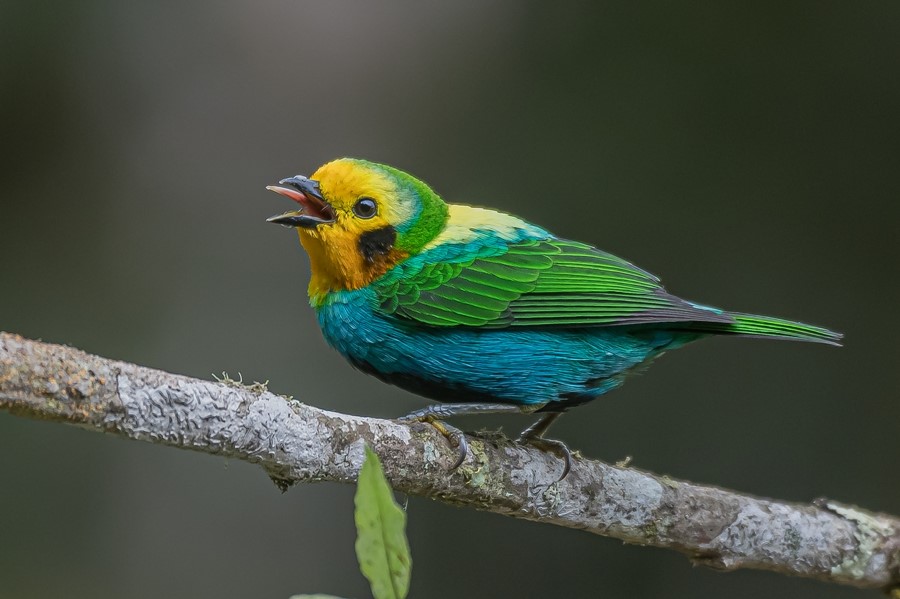
Day 2. Birding Reserva La Florida and transfer to Popayan
We will have an early start to visit Reserva La Florida where we will have the chance to see a family of endemic Chestnut Wood Quails coming to a feeder. Other classic bird species include Golden-naped Tanager, Saffron-crowned Tanager, Golden Tanager, Andean Motmot, Blue-winged Mountain Tanager, Green-and-black Fruiteater, Golden-crowned Flycatcher, Golden-winged Manakin and Golden-headed Quetzal, the endemic and striking Multicolored Tanager and the endemic Colombian Chachalaca. After lunch we will drive south to the colonial town of Popayan.
Overnight: Hotel Dann Monasterio, Popayan
Day 3. Birding Paramo de Purace
After a 1.5-hour drive, we shall reach the Paramo de Purace where, with a bit of luck, we will be able to see the majestic Andean Condor, Colombia’s national bird. Here the local communities feed the Andean Condor with animal carcasses, which offer good opportunities for photography. In addition to the condor, we may see Carunculated Caracara and Black-chested Buzzard-Eagle soaring above the paramo. Other species include Golden-plumed Parakeet, Grass-green Tanager, Buff-breasted MountainTanager, Golden-crowned Tanager, Black-backed Bush Tanager, Black-capped Hemispingus and hummingbird species such as Shining Sunbeam, Black-thighed Puffleg and the impressive Sword-billed Hummingbird. After lunch we will return to Popayan, looking for birds on the way to the hotel.
Overnight: Hotel Dann Monasterio Popayan
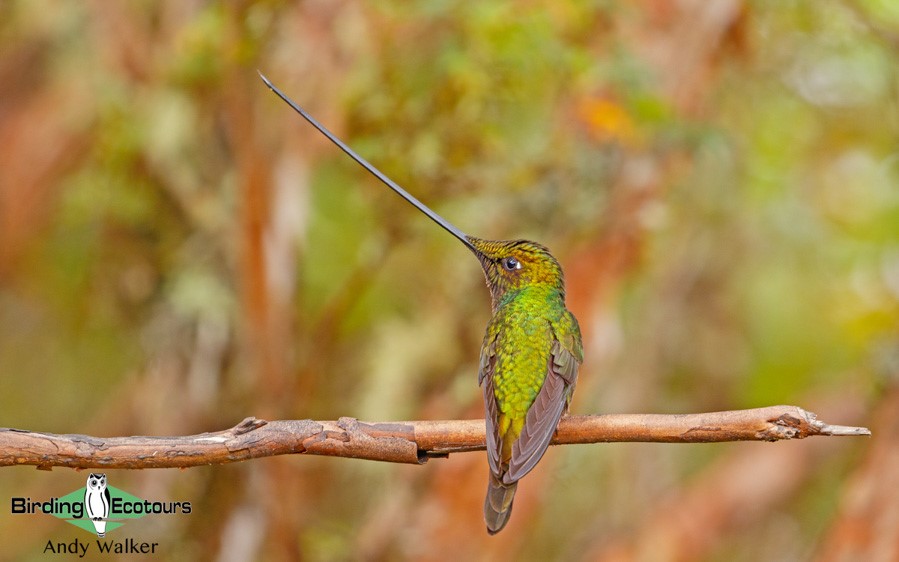
Day 4. Birding around the hotel and transfer to Pasto
The hotel surroundings offer great opportunities for species like Crested Bobwhite, the elusive Dwarf Cuckoo, Bar-crested Antshrike, Cocoa Thrush, Greenish Elaenia, Red-breasted Blackbird, White-lined Tanager, Buff-throated Saltator, Pearl Kite and two endemics: Greyish Piculet and Apical Flycatcher. By 10am we will start the long drive (5.5 hours) to Pasto and be transferred to our hotel.
Overnight: Chalet Guamuez, Pasto
Day 5. Birding the Paramo de Bordoncillo
Today we will explore the Paramo de Bordoncillo, a place that has only recently been put on the map for birdwatchers when the poorly-known Chestnut-bellied Cotinga was rediscovered in this remote part of Colombia. For Cotinga-lovers this is probably one of the main targets of the trip and one of the rarest and hardest to find anywhere in the world. We will focus most of our efforts on finding this mega rare species.
However, the paramo also includes other impressive species such as Masked Mountain Tanager, Grey-breasted Mountain Toucan, Carunculated Caracara, Bar-bellied Woodpecker, Paramo Tapaculo, White-browed Spinetail, Black-backed Bush Tanager and Spectacled Whitestart. After lunch we will visit Laguna La Cocha to look for species such as Noble Snipe, Andean Duck, Yellow-billed Pintail, Andean Gull and Black-backed Grosbeak.
Overnight: Chalet Guamez, Pasto
Days 6 – 7. Birding Trampolin Road (upper and lower sections)
The famous Trampolin Road, which joins the city of Pasto with Mocoa, is one of the most dramatic roads in Colombia, passing through different forest types from 8,200 feet (2,500 meters) to 1,900 feet (600 meters) above sea level, as it descends into the tropical upper Amazonia. Along the road, we will look for one of the main targets of the trip, the sought-after White-rimmed Brushfinch. Other birds to look out for along the road include Blue-browed Tanager, Bronze-green Euphonia, Black-billed Mountain Toucan, Golden-eared Tanager, Lined Antshrike, Western Fire-eye, Andean Cock-of-the-rock, Golden-eyed Flowerpiercer, Grey-mantled Wren, Orange-eared Tanager, Black-collared Jay, Dusky Piha, Red-ruffed Fruitcrow, Rufous-rumped Antwren, White-capped Tanager, Rufous-crested Tanager, Golden-collared Honeycreeper, Maroon-tailed Parakeet and hummingbirds such as Violet-fronted Brilliant and Chestnut-breasted Coronet.
Overnight: Hotel Suma Wasi, Mocoa
We’ll look for the rare White-rimmed Brushfinch along the Trampolin Road (photo Danial Orozco).
Day 8. Birding Campucana
Today we shall focus on the tropical forest known as the Campucana. Here we will look for the prized Coppery-chested Jacamar and also other delights such as Black-streaked Puffbird, Speckled Tanager, White-streaked Antvireo, Spot-winged Antbird, Southern Nightingale-Wren, Musician Wren, Orange-billed Sparrow, Rufous-naped Greenlet, Ecuadorian Tyrannulet, Foothill Stipplethroat, Yellow-breasted Antwren, White-crowned Manakin, Blue-rumped Manakin, Black-billed Treehunter, Short-tailed Antthrush and hummingbird species such as Blue-fronted Lancebill and Wire-crested Thorntail.
Overnight: Hotel Suma Wasi, Mocoa
Day 9. Birding El Escondite
Today we shall focus our birding efforts on a lower-elevation tropical forest where we hope to find species like White-eared Jacamar, Brown Jacamar, White-chinned Jacamar, Green-backed Trogon, Scarlet-crowned Barbet, Golden-collared Toucanet, Point-tailed Palmcreeper, White-chested Puffbird, Amazonian Trogon, Amazonian Motmot, Western Striolated Puffbird, Black-streaked Puffbird, Bare-necked Fruitcrow, Amazonian Umbrellabird, Riparian Antbird, Gilded Barbet, Scaled Fruiteater, Vermilion Tanager, Green-and-gold Tanager, Speckled Chachalaca and Long-billed Woodcreeper.
Overnight: Hotel Pakarii, Puerto Asis
Day 10. Birding Playa Rica
Playa Rica offers forest and wetland areas which provide perfect habitat for a number of species including the likes of Horned Screamer, Capped Heron, Limpkin, White-throated Toucan, Plum-throated Cotinga, Orange-fronted Plushcrown, Ivory-billed Aracari, Lafresnaye’s Piculet, Chestnut Woodpecker, Cream-colored Woodpecker and Yellow-tufted Woodpecker. We should also find other more common species such as Black Caracara, Silver-beaked Tanager, Turquoise Tanager, Red-capped Cardinal, Blue-headed Parrot and Lettered Aracari. If time permits, we will look for Amazon (Pink) River Dolphin on the Putumayo River
Overnight: Hotel Pakarii, Puerto Asis
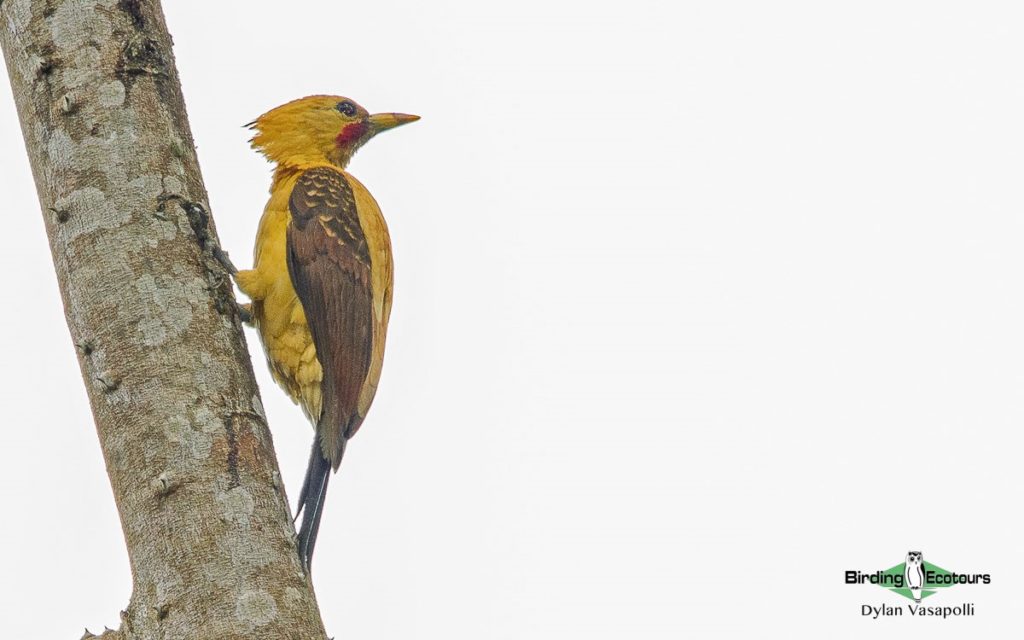
Day 11. Flight to Bogotá and visit to the hummingbird garden
We will continue our adventure by taking a domestic flight from Puerto Asis to Bogotá, from where we will transfer to La Calera to visit the hummingbird garden “Observatorio de Colibries” This private house offers beautiful gardens with great hummingbird feeders including species such as Sword-billed Hummingbird, the striking Blue-throated Starfrontlet, Glowing and Coppery-bellied Puffleg, Black-tailed Trainbearer and Longuemare’s Sunangel. Later we will transfer back to Bogota to stay near the airport.
Overnight: Courtyard by Marriot, Bogotá
Day 12. Flight to Yopal
We will be transferred to the airport and connect with a domestic flight to Yopal in the Casanara state, the entrance to the Colombian Llanos. If time permits, we could spend the morning birding La Florida Regional Park close to the airport before our domestic flight to Yopal. La Florida is a good spot for the endemic Bogota Rail, and other birds such as Subtropical Doradito, the endemic Apolinar’s Wren, the endemic Silvery-throated Spinetail, American Coot, Spot-flanked Gallinule, Common Gallinule, Bare-faced Ibis, Yellow-hooded Blackbird, Andean Duck, Southern Lapwing and Mountain Elaenia. If we do not have time for birding in Bogota before the flight, we can visit a place called Lagunaso in Yopal, where we can spend the afternoon looking for aquatic species.
Overnight: Hilton Hotel, Yopal
Jabiru and hordes of other waterbirds can be seen near Juan Solito Lodge (photo Alejandro Grajales).
Day 13. Yopal to Hato La Aurora and onwards to Juan Solito Lodge
After breakfast we will leave our hotel and head to Hato de La Aurora, birding the savannas and the seasonally flooded plains looking for species such as Double-striped Thick-knee, Maguari Stork, Jabiru, Wood Stork, Whistling Heron, American White Ibis, Scarlet Ibis, Sharp-tailed Ibis, King Vulture, Savanna Hawk, American Kestrel, Oriole Blackbird, Grassland Sparrow, Yellowish Pipit, Eastern Meadowlark and Burrowing Owl. We will arrive at Juan Solito Lodge for lunch and will spend the afternoon birding around the lodge. Juan Solito Lodge is located in the north-eastern corner of the Hato La Aurora ranch, right on the banks of the Ariporo River and acts as a perfect base from which to explore the vast and impressive Los Llanos.
Overnight: Juan Solito Lodge
Day 14. Birding Juan Solito, Hato La Aurora
We will start our adventure by exploring Los Llanos in safari-style 4×4 vehicles while scanning the vast savannas and wetlands for wildlife such as Capybara, Giant Anteater and even the mighty Anaconda. Los Llanos is probably one of the easiest places in the world to see this giant snake! However, our target species are, without doubt, the localized Pale-headed Jacamar and White-bearded Flycatcher, both restricted to the Llanos habitat. Other species include Festive Amazon, Scaled Piculet, Green-rumped Parrotlet, Plain-brown Woodcreeper, Violaceous Jay, Bicolored Wren, Purple-throated Euphonia, Masked Cardinal, Wire-tailed Manakin, Orange-fronted Yellow Finch, Masked Cardinal, Spectacled Thrush, Rufous-vented Chachalaca and vast numbers of aquatic species. At night, we will do another safari-style drive looking for nocturnal wildlife and birds and, with some luck we might see Jaguar or Lowland (Brazilian) Tapir.
Overnight: Juan Solito Lodge
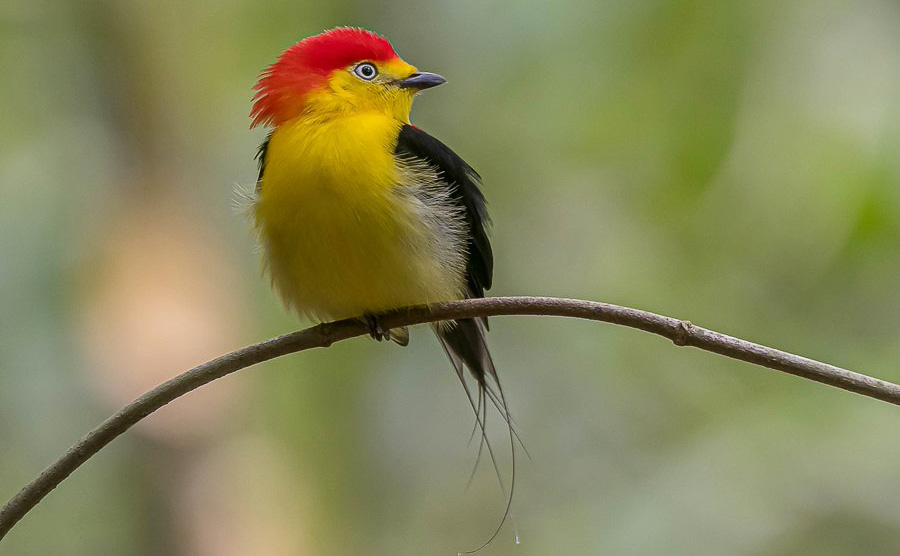
Day 15. Birding Juan Solito, Hato La Aurora
Today we will explore river channels by boat looking for species such as Orinoco Goose, Brazilian Teal, Rufous-vented Chachalaca, Crestless Curassow, Hoatzin, Sunbittern, Sungrebe, Boat-billed Heron, Roseate Spoonbill, American Pygmy Kingfisher, Green-and-rufous Kingfisher, Two-banded Puffbird, Venezuelan Troupial, Barred Antshrike, Northern Slaty Antshrike, Amazonian Black Tyrant, Orange-crowned Oriole, Chestnut-vented Conebill, Rosy Thrush-tanager and Orange-fronted Yellow Finch.
Overnight: Juan Solito Lodge
Day 16. Juan Solito and transfer back to Yopal
After a last morning enjoying the lodge surroundings, we will drive back to Yopal for our final night of the trip.
Overnight: Hilton Hotel, Yopal
Orinoco Goose is another one of our targets while in Los Llanos (photo Alejandro Grajales).
Day 17. Domestic flight to Bogotá and flight out
We will be transferred to the airport and catch our domestic flight to Bogotá. We will say farewell at Bogotá Airport after an amazing 17-day-long birding and wildlife adventure.
Please note that the itinerary cannot be guaranteed as it is only a rough guide and can be changed (usually slightly) due to factors such as availability of accommodation, updated information on the state of accommodation, roads, or birding sites, the discretion of the guides and other factors. In addition, we sometimes have to use a different international guide from the one advertised due to tour scheduling.
Download Itinerary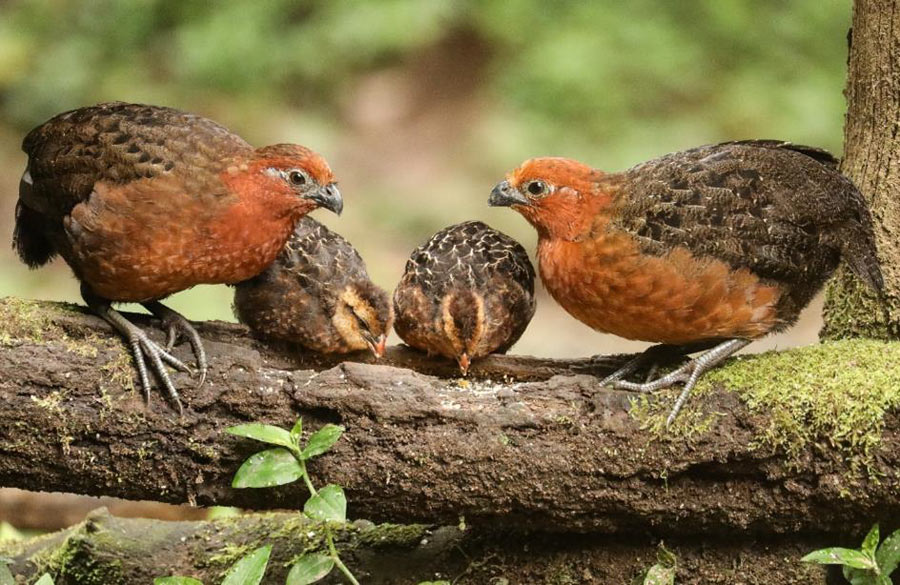
Chestnut Wood Quail, an endemic of Colombia (photo Chuck Gates).
In 2024, we ran a shorter version of our classic Colombia Uncovered birding tour, which focused on the main route from Cali to Puerto Asis in the Putumayo state, and added a couple of days in Bogotá to look for some special birds around the capital, instead of our typical days visiting the Llanos in Juan Solito. Please see our 2023 trip report where we birded the Llanos around Juan Solito, here. Our 2024 set departure was a great trip with a group of friends who had birded and traveled together many times before.
We started by visiting the humid montane cloud forest above Cali, enjoying a busy feeding station, feasting our eyes on several species of colorful birds, including the endemic and striking Multicolored Tanager,a contender for the most beautiful tanager in the world. We also saw the endemic Chestnut Wood Quail coming to the feeder with chicks.
Then we moved south for a taste of the Puracé National Park, where we admired the majestic Andean Condor and obligatory Grey-breasted Mountain Toucan. After a long drive, we arrived at the Paramo de Bordoncillo, where we found the rare Chestnut-bellied Cotinga,one of the many targets of this trip, without hiking at all!
We then descended in elevation, birding along the infamous Trampolin de la Muerte, a mountain road that joins the high-elevation Andes of Colombia in Pasto state with the Amazon rainforest foothills and lowlands near the Ecuadorian border. This is a fantastic route that provides quality mixed-species flocks, with beautiful and colorful tanagers, Andean Cock-of-the-rock and some range-restricted birds, such as the most-wanted White-rimmed Brushfinch.
The upper tropical lowlands provided beauties like Paradise Tanager and Wire-crested Thorntail. The Amazon lowlands yielded an excellent selection of birds like Cream-colored Woodpecker, White-chinned and White-eared Jacamars, Long-billed Woodcreeper, Spot-crowned Barbet, Chestnut-eared and Lettered Aracaris, Hoatzin, Ladder-tailed Nightjar, Black-capped Donacobious, Red-bellied Macaw, Opal-crowned Tanager and the localized Sapphire-rumped Parrotlet,amongst many others.
The Andes of Bogotá were good, with outstanding views of Andean Potoo, Muisca Antpitta, Black-headed Hemispingus, Bogota Rail, Whistling Heron, Green-bearded Helmetcrest, Black-billed Mountain Toucan, Blue-throated Starfrontlet and many more.
We enjoyed other wildlife as well, including a few endemic primates of Colombia and brief views of Pink River Dolphin and Spectacled Bear. This was a fun trip along a seldom-visited birding route in the most bird-diverse country in the world.
The group agreed to arrive a day early to be sure to be in town and ready for the start of the trip in a relaxed and organized way. We enjoyed a lovely supper at the hotel and discussed the tour plan and schedule.
We had an early start and drove to La Florida, a private bird reserve that has become very popular among local and international birders in recent years due to its great feeding stations. On arrival, we spent the whole morning at the “moth trap”, where we got super views of Grey-breasted Wood Wren and Russet-crowned Warbler showing very well, right out in the open. Other interesting birds included Variegated Bristle Tyrant, Streak-capped Treehunter, Montane Woodcreeper, Red-faced Spinetail, Northern Tropical Pewee, Black-and-white Warbler, Blackburnian Warbler, Canada Warbler, Slate-throated Whitestart and Narino Tapaculo (heard only).

Multicolored Tanager, perhaps the most striking Colombian endemic (photo Daniel Orozco).
Perhaps the most excitement came when an endemic Multicolored Tanager came in at eye level and posed well for pictures. This was truly a special moment with one of the most beautiful and colorful birds of the neotropics. This bird has only become accessible at feeders in the Cali area in the last ten years. Before that, it was tricky to get good views, since it was usually only seen in mixed-species flocks in the cloud forest canopy in only a handful of places in Colombia. Other birds that we saw at the feeders included Red-headed Barbet, Crimson-rumped Toucanet, Golden-naped, Golden, Flame-rumped, Saffron-crowned, Blue-grey, Palm and Metallic-green Tanagers.
Additionally, we secured good views of Blue-winged Mountain Tanager, Green Honeycreeper, Black-billed Thrush, Saffron Finch, Bananaquit, White-naped Brushfinch, Chestnut-capped Brushfinch, Orange-bellied Euphonia and Acorn Woodpecker. We also saw Common Potoo at its daytime roost as well as Sickle-winged Guan and Andean Motmots in the lodge garden. Some of the birds that remained heard only for the day included Bright-rumped Attila, Colombian Chachalaca, Squirrel Cuckoo and Andean Solitaire.
Of course, the hummingbirds were a blast and kept us entertained for a good while, providing excellent views of White-necked Jacobin, Speckled Hummingbird, Brown Violetear, Fawn-breasted Brilliant, White-booted Racket-tail, Bronzy Inca, Andean Emerald, Greenish Puffleg, and Steely-vented Hummingbird, with brief views of Tawny-bellied and Green Hermit.
Another highlight of the day was witnessing several visits of the endemic Chestnut Wood Quail with chicks, making birders and photographers very happy.
We then had a tasty local lunch and left Cali and drove south towards Popayan, the capital of the Cauca department.
After breakfast, we enjoyed views of Southern Lapwing in the hotel grounds. We then drove above Popayan to the Puracé National Park below the paramo of the Cauca department. Here, we visited the Cruz del Condor sector, where, accompanied by members of the local community, we went to the Cruz del Condor stakeout to wait for the national bird of Colombia (as well as Ecuador, Chile and Bolivia). It was drizzling, windy, and overcast, and as time went on, it seemed increasingly likely that we would unfortunately miss the condor today. While we were waiting we had several good views of Carunculated Caracara, and then the Andean Condor flew above the stakeout and around us to finally land on the huge rock on the cliff where the locals had left some bait for it. We had phenomenal, close views of the condor!
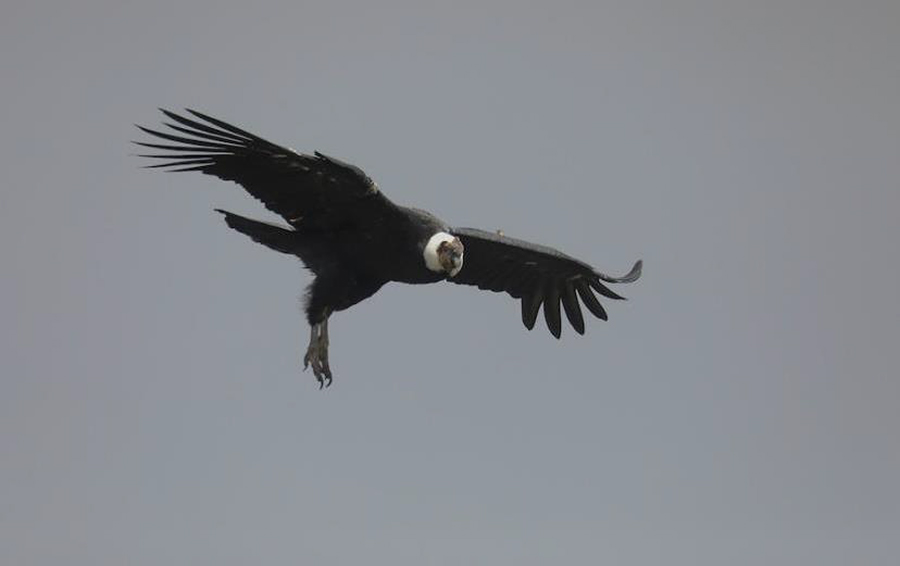
Andean Condor (photo Chuck Gates).
Other birds seen at the stakeout included Greenish Puffleg, Band-tailed Pigeon and White-collared Swift.We birded along the road for a while, and the activity was very quiet until we got our first targets, including the widespread but beautiful, Scarlet-bellied Mountain Tanager,as well as great views of Grey-breasted Mountain Toucan, which performed very well for us. Additionally, we saw Sierran Elaenia, Great Thrush, Andean Siskin, Inca Jay, Mountain Cacique, Hooded Mountain Tanager, Blue-capped Tanager, Lacrimose Mountain Tanager, Superciliaried Hemispingus, Blue-and-black Tanager, Blue-backed Conebill, Masked Flowerpiercer, White-naped Brushfinch and Blackburnian Warbler.
We ate lunch in the community and then visited a garden with some feeders, where we saw Shining Sunbeam, Buff-winged Starfrontlet, Greenish Puffleg and Sparkling Violetear.We had great views of Golden-fronted Whitestart and Crimson-mantled Woodpecker. Then we drove back to Popayan for the night.
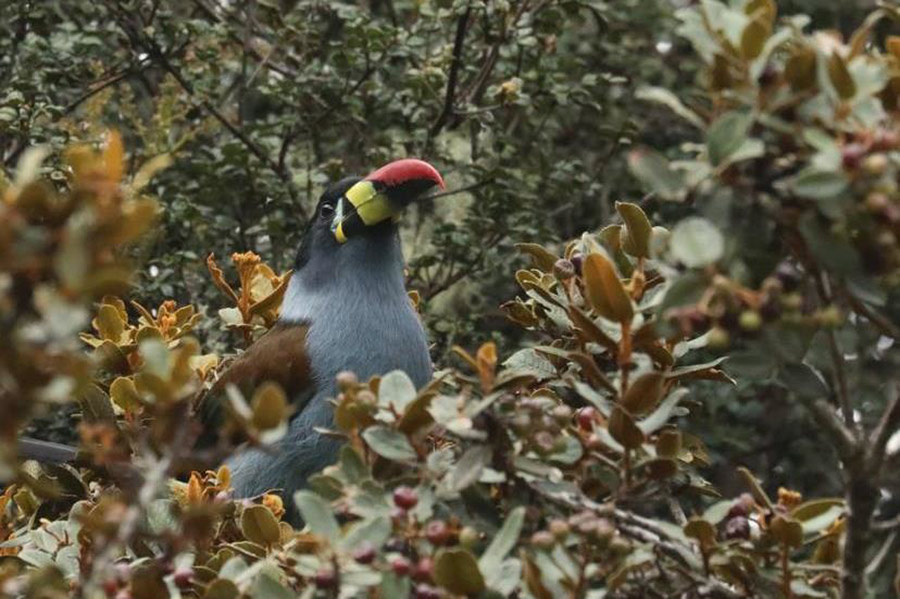
Grey-breasted Mountain Toucan (photo Chuck Gates).
Today was mostly a travel day as we made our way from Popayan all the way south to the Guamuez Lake (also known as Laguna La Cocha) in the Nariño department, above the city of Pasto. It was one of the longest drives of the trip, but it was necessary to explore the montane and upper tropical forest of the infamous Trampolin de la Muerte. We stopped along the road and were able to add some interesting species, such as the endemic Apical Flycatcher, Pale-vented Pigeon, Crested and Yellow-headed Caracaras, Common Tody-Flycatcher, Chivi Vireo, Yellow-bellied Elaenia, Scrub Tanager, Thick-billed Seed Finch, Yellow-bellied Seedeater, Yellow-faced Grassquit, Yellow Warbler and Lesser Goldfinch. We arrived at the Laguna La Cocha, located at an altitude of 8,530 feet (2,600 meters). At night, we heard Rufous-banded Owl around the cabins when the temperature dropped to less than 50°F (10°C)!
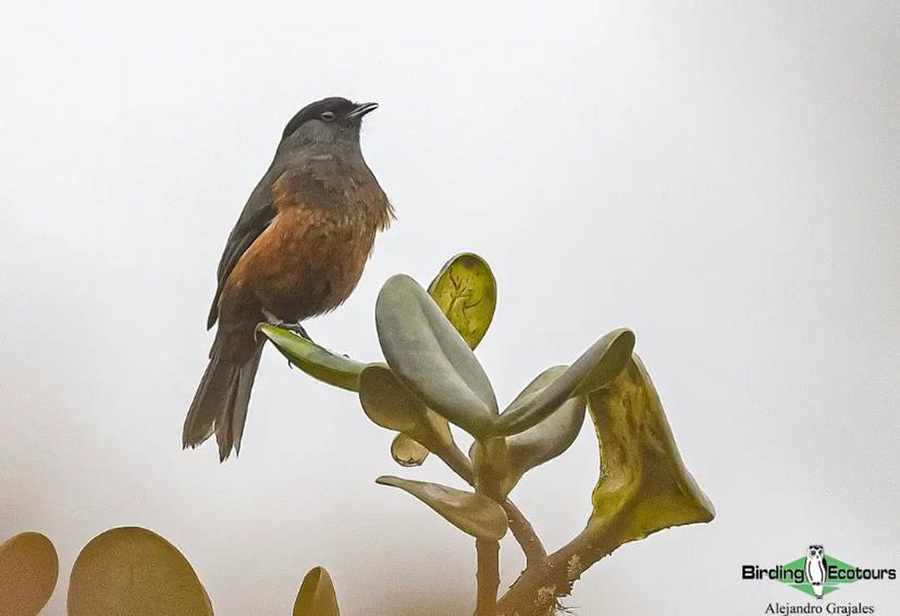
Chestnut-bellied Cotinga,mega of the Andes.
Today, our main goal was to explore the Paramo de Bordoncillo, a place that has caught the attention of birders for the past decade thanks to consecutive records of the poorly known Chestnut-bellied Cotinga. This is one of the rarest birds in the whole of the Andes, (where it also occurs in Ecuador), but it is tough to find anywhere.
The weather was not promising, but fortunately, it was not raining. We started birding along a steep trail when Donna suddenly spotted a bird, and there it was; the Chestnut-bellied Cotinga! We did not even have to reach the ridge – a challenging task for anyone who is not physically fit – but thankfully we found it very easily and could enjoy it big time.
We also had good encounters with Tawny Antpitta (an individual who appeared to have an injured foot), White-banded Tyrannulet, Agile Tit-Tyrant, Brown-backed Chat-Tyrant, Hooded, Scarlet-bellied and Lacrimose Mountain Tanagers, Golden-crowned Tanager, Mountain Wren, Slaty Brushfinch, Pale-naped Brushfinch, Glossy Flowerpiercer, Tyrian Metaltail and White-chinned Thistletail.At the end of a lovely day of birding, we went to Mocoa for the night.
On our 2023 Colombia Uncovered tour, we could not explore this area because of the destruction caused by a massive landslide that made the road to Pasto unusable. Thus, in 2023, we took a detour from Puracé to Huila and then to Mocoa. This gave us the opportunity to visit other areas, such as El Encanto Reserve in the Huila, where we saw Hooded Antpitta, Tolima Dove and Red-bellied Grackle attending feeding stations. We also spent more time at the Vereda Campuna, where we recorded Golden-winged Tody-Flycatcher. Unfortunately, Paramo de Bordoncillo and the Trampolin were unavailable to us on that tour, so we were eagerly anticipating going there on this 2024 tour.
The birds behaved well despite the non-stop rain every day until the end of our trip. Some of the remarkable species we encountered along this route included Yellow-throated Tanager (which just sneaks into Colombia from Ecuador, here at its northern limit). This can be easy to see in northern Peru and Ecuador, but in Colombia, it is found only in this area. Other birds seen were Blue-winged Mountain Tanager, Beryl-spangled, Flame-faced, Saffron-crowned, Metallic-green, Blue-and-black, Blue-grey, Blue-necked, Blue-capped and Golden Tanagers. Grass-green Tanager showed very well along the road down from Paramo de Bordocillo to the upper section of the Trampolin, and it was a highlight for some tour participants.
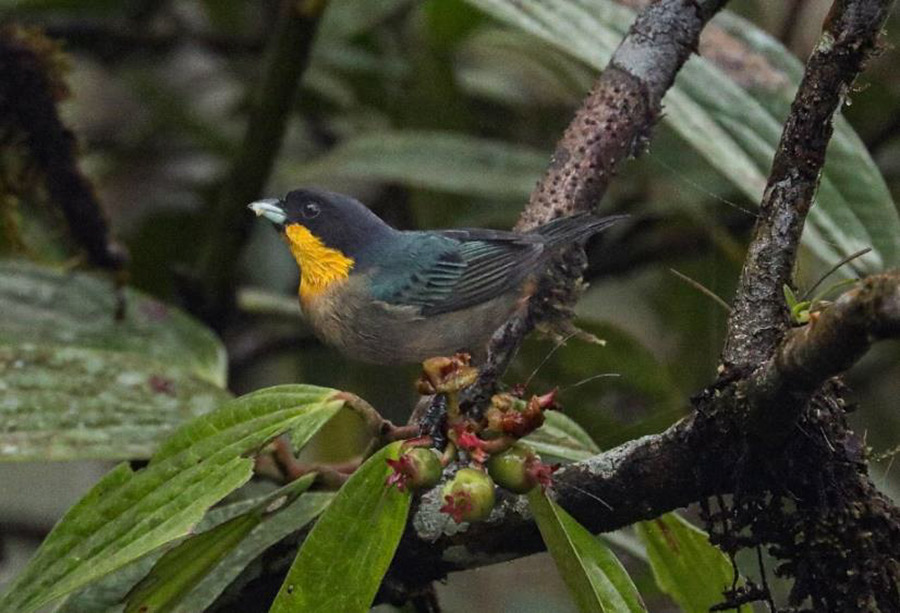
Yellow-throated Tanager (photo Chuck Gates).
We saw the obligatory Golden-eyed Flowerpiercer (previously known as Deep-blue Flowerpiercer), Three-striped Warbler, Canada Warbler, Scarlet-rumped Cacique, Pale-naped Brushfinch, Common Chlorospingus (here of the race nigriceps), Mountain Wren and Sepia-brown Wren (also known as Sharpe’s Wren).
We encountered a nice mixed-species feeding flock, with Sulphur-bellied Tyrannulet, Handsome Flycatcher, White-banded Tyrannulet, Golden-bellied Flycatcher, Rufous-breasted Flycatcher, Spotted Barbtail, Streaked Xenops, Black-and-white Warbler and Blackburnian Warbler. We also heard White-bellied Antpitta far away from the road. We then went to look for the White-rimmed Brushfinch – a sought-after species in South America – and saw it well, but it was difficult to photograph due to the poor light conditions. (It is also found in the southern Andes of Colombia and northern Andes of Ecuador, north and east of Quito).
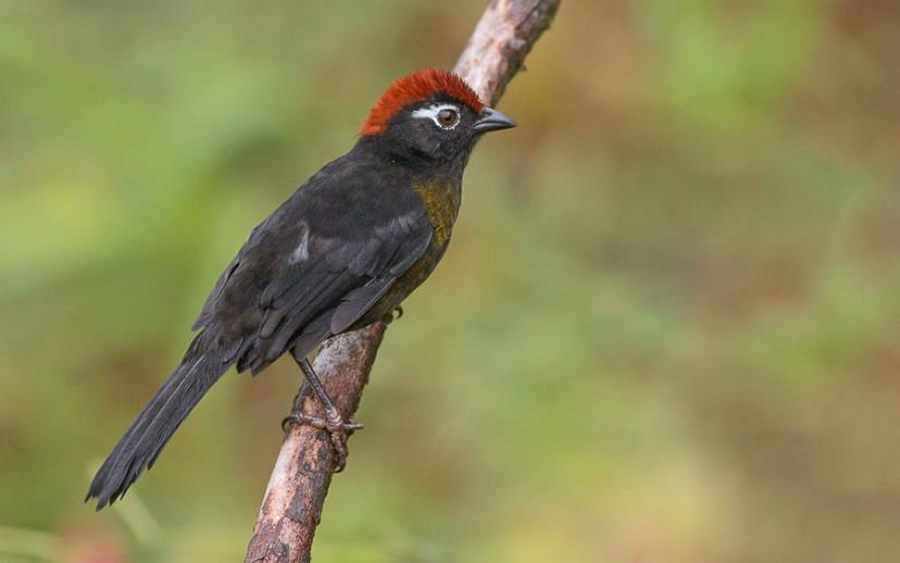
The range-restricted White-rimmed Brushfinch (photo Daniel Orozco).
We left Mocoa with a packed breakfast and returned to the Trampolin to explore the mid to lower parts. We found upper tropical forest species such as Andean Cock-of-the-rock, spotted by Donna, who also saw a Red-ruffed Fruitcrow male, unfortunately missed by the rest of us. We then saw Plumbeous Pigeon, Speckled Chachalaca and Chestnut-eared Aracari, which was spotted and photographed well by Chuck. We heard Black Tinamou in the forest down the road, but it was in an inaccessible spot. Jeff and I managed to see Wattled Guan which then disappeared into the lush forest. Additionally, Lineated and Crimson-crested Woodpeckers, Russet Antshrike, Yellow-crowned Tyrannulet, Black-crowned Tityra, Violaceus Jay, White-lored, Thick-billed and Orange-bellied Euphonias, Yellow-throated Chlorospingus and Orange-eared Tanager were seen. Golden-eared Tanager was the next bird we enjoyed. In the lower parts, we had an excellent encounter with Yellow-handed Titi.
Later we explored the surroundings of Mocoa in the Vereda Rumiyacu sector and had views of Speckled Chachalaca, Squirrel Cuckoo, Gilded Barbet, Chestnut-eared Aracari, Cream-colored Woodpecker, Orange-fronted Plushcrown, Grey-capped Flycatcher, Black-crowned Tityra, Red-capped Cardinal, Violaceous Jay, White-lined, Swallow and Turquoise Tanagers, Yellow-crowned Tyrannulet, Yellow-tufted and Little Woodpeckers and Swallow-tailed and Plumbeous Kites.One of the stars of the afternoon was Cerulean Warbler,a lifer for several participants, even though this bird is widespread across the Americas. Another unusual species was Blackpoll Warbler.
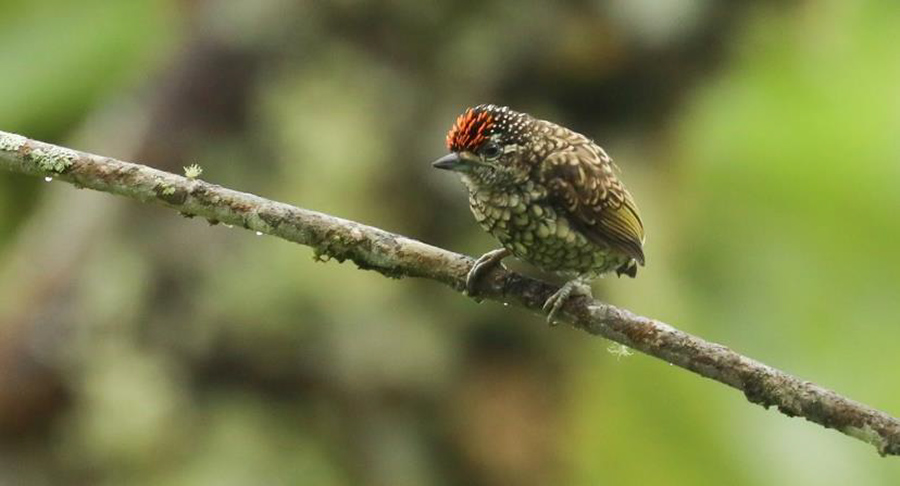
Scaled Piculet in the Colombian foothills (photo Chuck Gates).
This morning we explored Vereda Rumiyacu, where we had Cobalt-winged Parakeet, Buff-throated Woodcreeper, Piratic Flycatcher, Yellow-browed Sparrow, Black-billed Thrush, Scarlet Tanager, Purple Honeycreeper, Masked Tanager, Chestnut-bellied Seed Finch, Thick-billed, Orange-bellied and Bronze-green Euphonias. We also had views of White-lored Euphonia, sometimes also known as Golden-bellied Euphonia. The name of the genus, Euphonia,is of Greek origin and refers to the bird’s “pleasing song”. The genus was described in the 19th century by the French zoologist Anselme Gaetan Desmarest.
We repeated some of the birds we had seen the previous day, as well as Chestnut Woodpecker (seen in flight several times), Lettered Aracari, Plumbeous Pigeon, Short-crested Flycatcher and we enjoyed scope views of the striking Plum-throated Cotinga.
Later, we explored a section of the road between Mocoa and Huila called Finca, where a local family allows birders to visit their land and look for birds on their property. This is a good spot to see Wire-crested Thorntail, which we saw well, albeit briefly. We also saw Paradise Tanager, a target for several of the participants. We then had Black-throated Mango, Long-billed Starthroat, Blue-headed Parrot, Ochre-lored Flatbill, Long-tailed Tyrant, Lemon-browed Flycatcher, Yellow-green Vireo, Yellow-bellied Tanager, Green-and-gold Tanager (not seen by everybody), Swallow and Silver-beaked Tanager and heard Thrush-like Antpitta calling from deep within the forest. After spending time here in the company of a very enthusiastic and warm local family, we returned to Mocoa. Unfortunately, there was no time to explore the road up to the property where we had seen Golden-winged Tody-Flycatcher on last year’s tour.
Back in Mocoa, we tried for Band-bellied Owl on the outskirts of town, but sadly, it was not calling, most likely due to the light drizzle. The owls did not cooperate much during this trip.
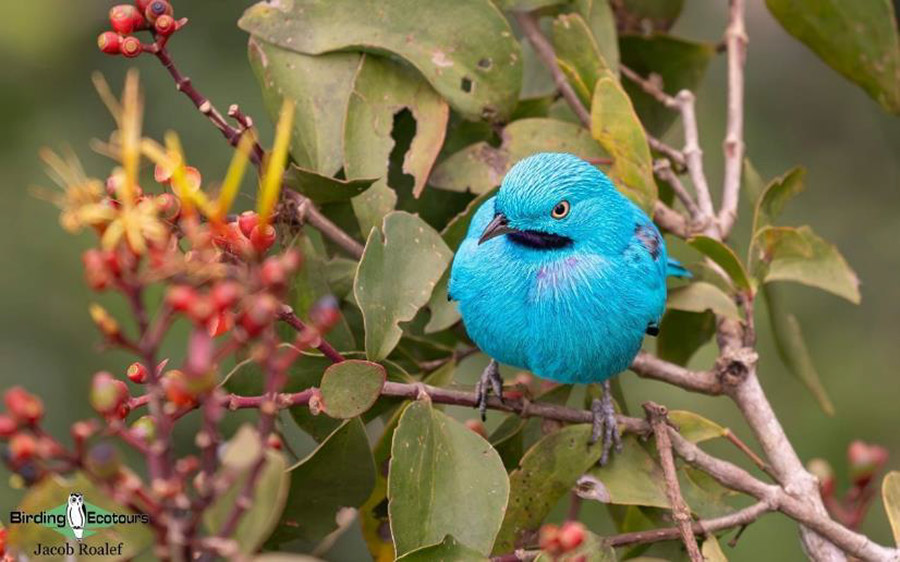
Plum-throated Cotinga was a pleasant surprise on the trip.
We left Mocoa towards Puerto Asis in the Putumayo department and visited an area known as The Escondite (the hide), an excellent place to see certain lowland species and one of the best for Sapphire-rumped Parrotlet. This parrot species is restricted to northern South America and can sometimes be overlooked since they feed quietly in the forest canopy and sub-canopy; however, this place offers good chances for them. We arrived, and guess what? It was raining!
After breakfast we found Amazonian Trogon, Red-bellied Macaw, Cinnamon Attila, Thrush-like Wren, Yellow-browed Tody-Flycatcher, Boat-billed Flycatcher, Cinnamon-throated and Plain-brown Woodcreepers, White-chinned Jacamar, Scarlet-crowned Barbet and Lafresnaye’s Piculet (named after the 19th century French ornithologist and collector Frédéric de Lafresnaye). We also saw Crimson-crested Woodpecker and heard Laughing Falcon. We reached an open grassy area where we had great views of Hoatzin and a glimpse of Rufous-sided Crake. Here, we also saw Pale-vented Pigeon, White-collared and Grey-rumped Swifts, Wattled Jacana, Rufescent Tiger Heron, Green and Bare-faced Ibises, Magpie Tanager and Spot-breasted Woodpecker. We heard Undulated Tinamou, one of the classic sounds of the Amazon rainforest.
Near the ruins of an old school, we sheltered from the rain and managed to see Sapphire-rumped Parrotlet,which showed very well for us, feeding quietly in a tree and flying around and returning now and again.
After lunch, we went to our hotel near Puerto Asis and had great views of Amazon Night Monkey during the day. In the evening, we shared a delicious meal and drinks to say goodbye to our friends Steve and Laura, who were flying back to Bogotá the next day to connect with their international flights. We thoroughly enjoyed their company on the trip, including Steve’s birthday, and hope to travel together again in the future.
Our schedule for the day was to sail in a boat across the Putumayo River to the local village of Playa Rica. As we drove to the port, the weather looked awful for birding. We birded as much as possible when we arrived at the village and waited for the weather to improve.
We found one of the birds we really wanted to see most, the impressive Long-billed Woodcreeper. The village area provided Greater Ani, Grey-fronted Dove and Sunbittern, which initially had Chuck in desperation boulevard until he managed to get great photographic shots. We further saw Ringed, Amazon and Green Kingfishers, Black-fronted Nunbird, Scarlet-crowned Barbet, White-eared Jacamar, Swallow-winged Puffbird, Black Caracara, Cream-colored Woodpecker, Dusky-headed Parakeet, Great Antshrike, Buff-throated Woodcreeper, Bare-necked Fruitcrow, White-winged Becard, Yellow-margined Flatbill, Lesser Kiskadee, White-winged and White-banded Swallows, Orange-backed Troupial and Opal-crowned Tanager. Here, we also saw Red-crowned Titi, endemic to the Putumayo River, and had a good look at it.
At Cuembi, right next to the Ecuadorian border, we had brief glimpses of Pink River Dolphin, seeing their backs when they came up to breathe. It was a worthwhile and enjoyable experience. We got the usual suspects and new ones, including Black Skimmer, Cocoi Heron, Pied Water Tyrant and Ladder-tailed Nightjar.
Today we headed to Puerto Asis airport and said goodbye to our local ground crew, Jovanni and Brian. We then flew to Bogotá, arriving in the afternoon, and rested at the hotel before our upcoming days in the eastern Andes.
It was another day in the field, and it was good to start with no rain and cool weather, instead of hot and humid weather. After a predawn breakfast on the way, we arrived at the Chingaza National Park where the birding was slow, except for Andean Guan, Purple-backed Thornbill, the endemic Bronze-tailed Thornbill, Great Sapphirewing, Tyrian Metaltail, Brown-bellied Swallow, Blue-backed Conebill, Masked Flowerpiercer, Plumbeous Sierra Finch, Rufous-browed Conebill, Blue-and-black Tanager and Glossy Flowerpiercer. The endemic Green-bearded Helmetcrest was spotted by Dorothy and gave brief views for all except Jeff, and no matter how much we tried, we could not find it again. We also heard Muisca Antpitta in the vicinity, but there were no views this time.
A bonus was a huge male Spectacled Bear which crossed the road and disappeared into the paramo. Spectacled Bear is the only species of bear (Ursidae) in South America. The Colombian population lacks beige facial coloring, showing a darker face than the Peruvian and Ecuadorian populations.
In the afternoon, we visited Observatorio de Colibries La Calera, where the activity was slow, but we added the endemic Blue-throated Starfrontlet to our list.
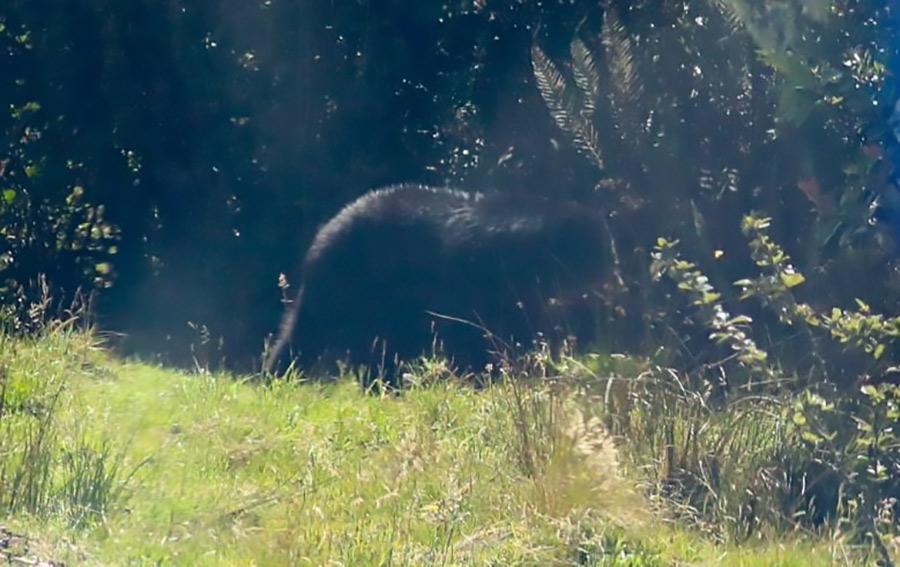
Spectacled Bear in the Colombian paramo (photo Chuck Gates).
Today was to be our last day birding together as our trip was coming to an end, and it proved to be one of the best days of the whole trip, with high quality birds and almost no rain. We met our local guide, who was authorized to guide within the Reserva Bosque Guajira, a buffer zone of the Chingaza National Park. We met him at Guasca after a lovely breakfast. We headed into the field, where we hit our first feeding flock, with species such as Rufous Wren, White-throated Tyrannulet, Pale-naped Brushfinch, Black-crested Warbler, Golden-crowned Warbler, Rufous-browed and Blue-backed Conebills, White-sided, Bluish, Masked and Glossy Flowerpiercers, Hooded and Scarlet-bellied Mountain-Tanagers, Mountain Elaenia and Pearled Treerunner. Excitement soared with amazing views of Black-headed Hemispingus, a bird not widespread in the Andes, being found only in Colombia and Ecuador, with old records in Piura state in the Andes of northern Peru.
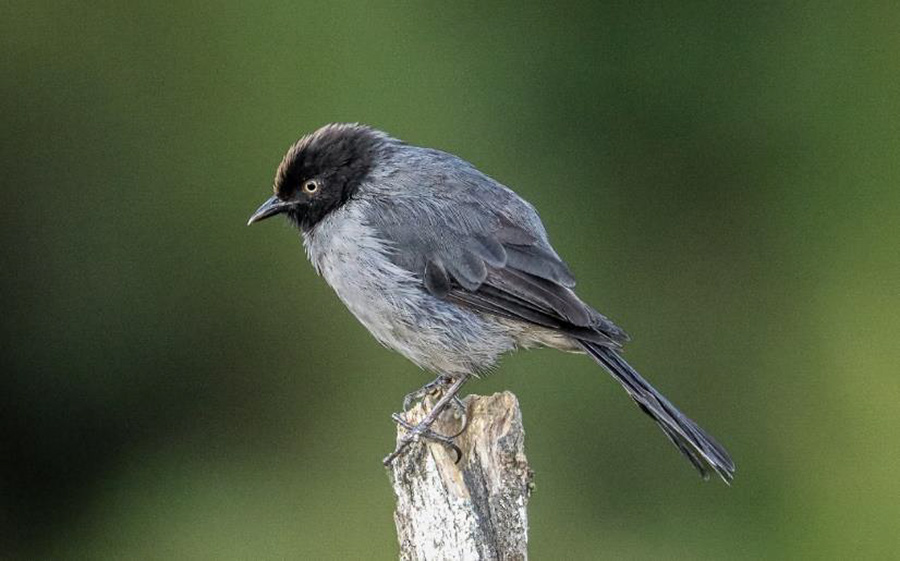
Black-headed Hemispingus,one of the highlights around Bogotá (photo Chuck Gates).
At an antpitta feeding station, we got superb views of the localized Muisca Antpitta,a recent split from Rufous Antpitta. The name is derived from the Muisca civilization of the eastern Andes of Colombia, which continues to this day in parallel with modern Colombian society. Other good birds of the day included Black-billed Mountain Toucan and incredible views of the seldom-seen Andean Potoo roosting during the daytime. We had a moderately challenging walk to get this last one, but everybody tried hard, and the effort paid off in the end.
Next, we visited a hummingbird feeder station which provided great species like Glowing Puffleg, Loguemare’s Sunangel, Great Sapphirewing, Buff-tailed Coronet, White-bellied Woodstar and Lesser Violetear.
We returned to Guasca to explore the wetlands of Siache. On the way, we found the endemic and endangered Flame-winged Parakeet (also known as Brown-breasted Parakeet). Although we only had scope views because of the distance, we saw them well.
Once in the wetlands, we looked for the endemic Bogota Rail, which we saw very well. Other species seen here were Common Gallinule, Andean Teal and we had flushed views of Noble Snipe. The endemic Silvery-throated Spinetail proved hard but eventually allowed for reasonably good views along with Torrent Tyrannulet, Yellow-hooded Blackbird, Grey-browed Brushfinch and Band-tailed Seedeater.
Then we transferred back to Bogotá and had a ludicrous traffic jam before we reached our hotel. That evening we enjoyed our last dinner together as a group in the hotel.
After a decent wake-up time and a lovely breakfast, we transferred to the airport and said our goodbyes. This adventure was fantastic, with an incredible group of friends in a beautiful country. I hope to travel with them again soon.
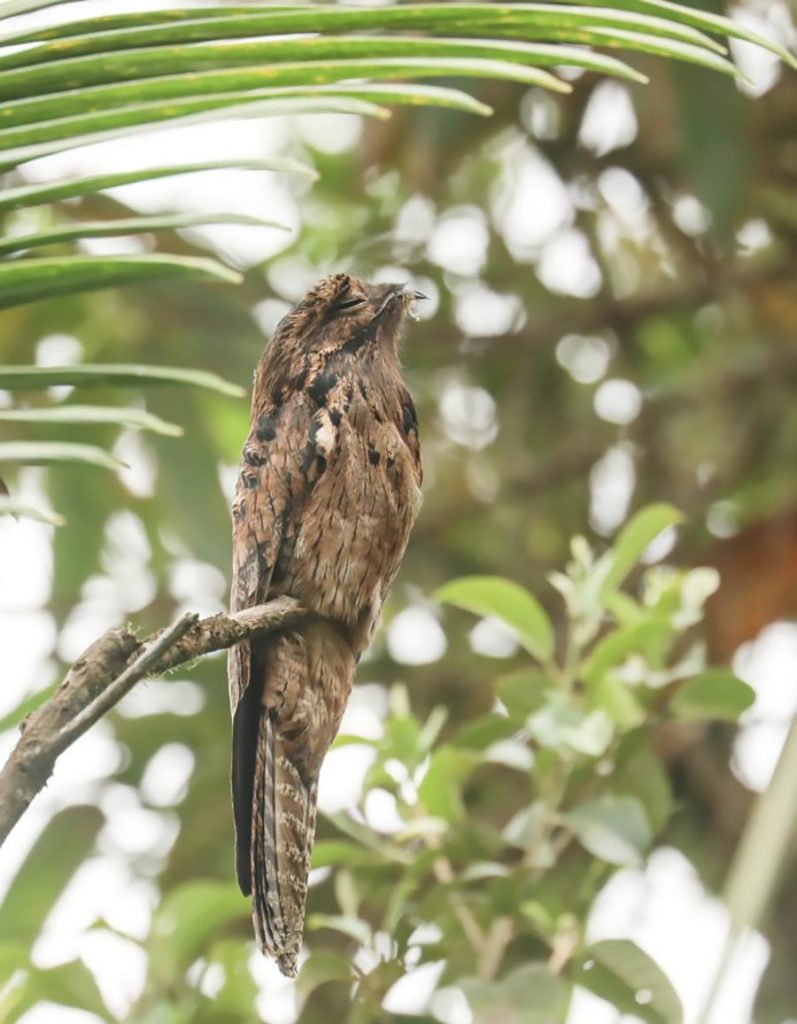
Andean Potoo (photo Chuck Gates).
Birds ‘heard only’ are marked with (H) after the common name, all other species were seen.
| Common name | Scientific name |
| Tinamous (Tinamidae) | |
| Black Tinamou (H) | Tinamus osgoodi |
| Undulated Tinamou (H) | Crypturellus undulatus |
| Cinereous Tinamou (H) | Crypturellus cinereus |
| Ducks, Geese, Swans (Anatidae) | |
| Muscovy Duck | Cairina moschata |
| Blue-winged Teal | Spatula discors |
| Yellow-billed Pintail | Anas geórgica |
| Andean Teal | Anas andium |
| Andean Duck | Oxyura ferrugínea |
| Chachalacas, Curassow, Guans (Cracidae) | |
| Speckled Chachalaca | Ortalis guttata |
| Colombian Chachalaca (H) | Ortalis columbiana |
| Andean Guan | Penelope montagnii |
| Wattled Guan | Aburria aburri |
| Sickle-winged Guan | Chamaepetes goudotii |
| Odontophoridae (New Word Quail) | |
| Chestnut Wood Quail | Odontophorus hyperythrus |
| Nightjars (Caprimulgidae) | |
| Pauraque | Nyctidromus albicollis |
| Ladder-tailed Nightjar | Hydropsalis climacocerca |
| Potoos (Nyctibiidae) | |
| Common Potoo | Nyctibius griseus |
| Andean Potoo | Nyctibius maculosus |
| Swifts (Apodidae) | |
| White-collared Swift | Streptoprocne zonaris |
| Grey-rumped Swift | Chaetura cinereiventris |
| Short-tailed Swift | Chaetura brachyura |
| Fork-tailed Palm Swift | Tachornis squamata |
| Hummingbird (Trochilidae) | |
| White-necked Jacobin | Florisuga mellivora |
| Green Hermit | Phaethornis guy |
| Tawny-bellied Hermit | Phaethornis syrmatophorus |
| Brown Violetear | Colibri delphinae |
| Lesser Violetear | Colibri cyanotus |
| Sparkling Violetear | Colibri coruscans |
| Black-throated Mango | Anthracothorax nigricollis |
| Longuemare’s Sunangel | Heliangelus clarisse |
| Tourmaline Sunangel | Heliangelus exortis |
| Wire-crested Thorntail | Discosura popelairii |
| Speckled Hummingbird | Adelomyia melanogenys |
| Long-tailed Sylph | Aglaiocercus kingii |
| Green-tailed Trainbearer | Lesbia nuna |
| Purple-backed Thornbill | Ramphomicron microrhynchum |
| Green-bearded Helmetcrest | Oxypogon guerinii |
| Bronze-tailed Thornbill | Chalcostigma heteropogon |
| Tyrian Metaltail | Metallura tyrianthina |
| Viridian Metaltail | Metallura williami |
| Greenish Puffleg | Haplophaedia aureliae |
| Glowing Puffleg | Eriocnemis vestita |
| Shining Sunbeam | Aglaeactis cupripennis |
| Bronzy Inca | Coeligena coeligena |
| Collared Inca | Coeligena torquata |
| Buff-winged Starfrontlet | Coeligena lutetiae |
| Blue-throated Starfrontlet | Coeligena helianthea |
| Great Sapphirewing | Pterophanes cyanopterus |
| Buff-tailed Coronet | Boissonneaua flavescens |
| White-booted Racket-tail | Ocreatus underwoodii |
| Fawn-breasted Brilliant | Heliodoxa rubinoides |
| Long-billed Starthroat | Heliomaster longirostris |
| Purple-throated Woodstar | Philodice mitchellii |
| Western Emerald | Chlorostilbon melanorhynchus |
| Steely-vented Hummingbird | Saucerottia saucerottei |
| Andean Emerald | Uranomitra franciae |
| Glittering-throated Emerald | Chionomesa fimbriata |
| Cuckoos (Cuculidae) | |
| Greater Ani | Crotophaga major |
| Smooth-billed Ani | Crotophaga ani |
| Squirrel Cuckoo | Piaya cayana |
| Pigeons, Doves (Columbidae) | |
| Rock Dove | Columba livia |
| Pale-vented Pigeon | Patagioenas cayennensis |
| Band-tailed Pigeon | Patagioenas fasciata |
| Plumbeous Pigeon | Patagioenas plúmbea |
| Ruddy Pigeon | Patagioenas subvinacea |
| Plain-breasted Ground Dove | Columbina minuta |
| Ruddy Ground Dove | Columbina buckleyi |
| White-tipped Dove | Leptotila verreauxi |
| Eared Dove | Zenaida auriculata |
| Rails, Crakes & Coots (Rallidae) | |
| Bogota Rail | Rallus semiplumbeus |
| Ecuadorian Rail | Rallus aequatorialis |
| Sora | Porzana carolina |
| Common Gallinule | Gallinula galeata |
| Andean Coot | Fulica ardesiaca |
| Rufous-sided Crake | Laterallus melanophaius |
| Limpkin (Aramidae) | |
| Limpkin | Aramus guarauna |
| Podicipedidae | |
| Pied-billed Grebe | Podilymbus podiceps |
| Plovers (Charadriidae) | |
| Southern Lapwing | Vanellus chilensis |
| Semipalmated Plover | Charadrius semipalmatus |
| Pied Plover | Hoploxypterus cayanus |
| Collared Plover | Anarhynchus collaris |
| Jacanas (Jacanidae) | |
| Wattled Jacana | Jacana jacana |
| Sandpipers, Snipes (Scolopacidae) | |
| Noble Snipe | Gallinago nobilis |
| Spotted Sandpiper | Actitis macularius |
| Solitary Sandpiper | Tringa solitaria |
| Lesser Yellowlegs | Tringa flavipes |
| Greater Yellowlegs | Tringa melanoleuca |
| Pectoral Sandpiper | Calidris melanotos |
| Gulls, Terns, Skimmers (Laridae) | |
| Black Skimmer | Rynchops niger |
| Large-billed Tern | Phaetusa simplex |
| Andean Gull | Chroicocephalus serranus |
| Sunbittern (Eurypygidae) | |
| Sunbittern | Eurypyga helias |
| Anhinga, Darters (Anhingidae) | |
| Anhinga | Anhinga anhinga |
| Cormorant, Shags (Phalacrocoracidae) | |
| Neotropic Cormorant | Nannopterum brasilianum |
| Ibises, Spoonbills (Threskiornithidae) | |
| Bare-faced Ibis | Phimosus infuscatus |
| Green Ibis | Mesembrinibis cayennensis |
| Scarlet Ibis | Eudocimus ruber |
| Herons, Bitterns (Ardeidae) | |
| Rufescent Tiger Heron | Tigrisoma lineatum |
| Black-crowned Night Heron | Nycticorax nycticorax |
| Whistling Heron | Syrigma sibilatrix |
| Snowy Egret | Egretta thula |
| Western Cattle Egret | Bubulcus ibis |
| Striated Heron | Butorides striata |
| Great Egret | Ardea alba |
| Cocoi Heron | Ardea cocoi |
| Hoatzin (Opisthocomidae) | |
| Hoatzin | Opisthocomus hoazin |
| New World Vultures (Cathartidae) | |
| Andean Condor | Vultur gryphus |
| Black Vulture | Coragyps atratus |
| Turkey Vulture | Cathartes aura |
| Greater Yellow-headed Vulture | Cathartes melambrotus |
| Osprey (Pandionidae) | |
| Osprey | Pandion haliaetus |
| Kites, Hawks, Eagles (Accipitridae) | |
| Hook-billed Kite | Chondrohierax uncinatus |
| Swallow-tailed Kite | Elanoides forficatus |
| Plumbeous Kite | Ictinia plúmbea |
| Roadside Hawk | Rupornis magnirostris |
| Broad-winged Hawk | Buteo platypterus |
| Owls (Strigidae) | |
| Tropical Screech Owl (H) | Megascops choliba |
| Rufous-banded Owl (H) | Strix albitarsis |
| Band-bellied Owl (H) | Pulsatrix melanota |
| Ferruginous Pygmy Owl (H) | Glaucidium brasilianum |
| Trogons (Trogonidae) | |
| Golden-headed Quetzal (H) | Pharomachrus auriceps |
| Amazonian Trogon | Trogon ramonianus |
| Kingfishers (Alcedinidae) | |
| Amazon Kingfisher | Chloroceryle amazona |
| Green Kingfisher | Chloroceryle americana |
| Ringed Kingfisher | Megaceryle torquata |
| Motmots (Momotidae) | |
| Andean Motmot | Momotus aequatorialis |
| Jacamars (Galbulidae) | |
| White-eared Jacamar | Galbalcyrhynchus leucotis |
| White-chinned Jacamar | Galbula tombacea |
| Puffbirds (Bucconidae) | |
| Black-fronted Nunbird | Monasa nigrifrons |
| Swallow-winged Puffbird | Chelidoptera tenebrosa |
| Barbets (Capitonidae) | |
| Scarlet-crowned Barbet | Capito aurovirens |
| Gilded Barbet | Capito auratus |
| Red-headed Barbet | Eubucco bourcierii |
| Toucans (Ramphastidae) | |
| White-throated Toucanet | Aulacorhynchus albivitta |
| Crimson-rumped Toucanet | Aulacorhynchus haematopygus |
| Grey-breasted Mountain Toucan | Andigena hypoglauca |
| Black-billed Mountain Toucan | Andigena nigrirostris |
| Chestnut-eared Aracari | Pteroglossus castanotis |
| Lettered Aracari | Pteroglossus inscriptus |
| Woodpeckers (Picidae) | |
| Scaled Piculet | Picumnus squamulatus |
| Lafresnaye’s Piculet | Picumnus lafresnayi |
| Acorn Woodpecker | Melanerpes formicivorus |
| Yellow-tufted Woodpecker | Melanerpes cruentatus |
| Red-crowned Woodpecker | Melanerpes rubricapillus |
| Little Woodpecker | Veniliornis passerinus |
| Crimson-mantled Woodpecker | Colaptes rivolii |
| Spot-breasted Woodpecker | Colaptes punctigula |
| Chestnut Woodpecker | Celeus elegans |
| Cream-colored Woodpecker | Celeus flavus |
| Crimson-crested Woodpecker | Campephilus melanoleucos |
| Lineated Woodpecker | Dryocopus lineatus |
| Caracaras, Falcons (Falconidae) | |
| Black Caracara | Daptrius ater |
| Carunculated Caracara | Phalcoboenus carunculatus |
| Yellow-headed Caracara | Milvago chimachima |
| Crested Caracara | Caracara plancus |
| Laughing Falcon | Herpetotheres cachinnans |
| American Kestrel | Falco sparverius |
| African & New World Parrots (Psittacidae) | |
| Barred Parakeet | Bolborhynchus lineola |
| Orange-chinned Parakeet | Brotogeris jugularis |
| Cobalt-winged Parakeet | Brotogeris cyanoptera |
| Sapphire-rumped Parrotlet | Touit purpuratus |
| Blue-headed Parrot | Pionus menstruus |
| White-capped Parrot | Pionus seniloides |
| Bronze-winged Parrot | Pionus chalcopterus |
| Spectacled Parrotlet | Forpus conspicillatus |
| Maroon-tailed Parakeet | Pyrrhura melanura |
| Flame-winged Parakeet | Pyrrhura calliptera |
| Red-bellied Macaw | Orthopsittaca manilatus |
| Dusky-headed Parakeet | Aratinga weddellii |
| White-eyed Parakeet | Psittacara leucophthalmus |
| Ovenbirds (Furnariidae) | |
| Plain-brown Woodcreeper | Dendrocincla fuliginosa |
| Cinnamon-throated Woodcreeper | Dendrexetastes rufigula |
| Buff-throated Woodcreeper | Xiphorhynchus guttatus |
| Montane Woodcreeper | Lepidocolaptes lacrymiger |
| Long-billed Woodcreeper | Nasica longirostris |
| Black-billed Treehunter (H) | Thripadectes melanorhynchus |
| Streak-capped Treehunter | Thripadectes virgaticeps |
| Streaked Xenops | Xenops rutilans |
| Pearled Treerunner | Margarornis squamiger |
| Spotted Barbtail | Premnoplex brunnescens |
| Orange-fronted Plushcrown | Metopothrix aurantiaca |
| White-chinned Thistletail | Asthenes fuliginosa |
| Red-faced Spinetail | Cranioleuca erythrops |
| Silvery-throated Spinetail | Synallaxis subpudica |
| Antbirds (Thamnophilidae) | |
| Russet Antshrike | Thamnistes anabatinus |
| Great Antshrike | Taraba major |
| White-shouldered Antshrike (H) | Thamnophilus aethiops |
| Western Fire-eye (H) | Pyriglena maura |
| Antpittas (Grallariidae) | |
| Tawny Antpitta | Grallaria quitensis |
| Muisca Antpitta | Grallaria rufula |
| White-bellied Antpitta (H) | Grallaria hypoleuca |
| Tapaculos (Rhinocryptidae) | |
| Narino Tapaculo (H) | Scytalopus vicinior |
| Paramo Tapaculo (H) | Scytalopus opacus |
| Pale-bellied Tapaculo (H) | Scytalopus griseicollis |
| New World Flycatchers (Tyrannidae) | |
| Yellow-crowned Tyrannulet | Tyrannulus elatus |
| Yellow-bellied Elaenia | Elaenia flavogaster |
| Sierran Elaenia | Elaenia pallatangae |
| Mountain Elaenia | Elaenia frantzii |
| White-throated Tyrannulet | Mecocerculus leucophrys |
| White-banded Tyrannulet | Mecocerculus stictopterus |
| Sulphur-bellied Tyrannulet | Mecocerculus minor |
| Golden-faced Tyrannulet | Zimmerius chrysops |
| Agile Tit-Tyrant | Uromyias agilis |
| Variegated Bristle Tyrant | Pogonotriccus poecilotis |
| Slaty-capped Flycatcher (H) | Leptopogon superciliaris |
| Streak-necked Flycatcher | Mionectes striaticollis |
| Rufous-breasted Flycatcher | Leptopogon rufipectus |
| Handsome Flycatcher | Nephelomyias pulcher |
| Rufous-crowned Tody-Flycatcher | Poecilotriccus ruficeps |
| Common Tody-Flycatcher | Todirostrum cinereum |
| Yellow-browed Tody-Flycatcher | Todirostrum chrysocrotaphum |
| Yellow-margined Flatbill | Tolmomyias assimilis |
| Ochre-lored Flatbill | Tolmomyias flaviventris |
| Black Phoebe | Sayornis nigricans |
| Eastern Wood Pewee | Contopus virens |
| Northern Tropical Pewee | Contopus bogotensis |
| Vermilion Flycatcher | Pyrocephalus obscurus |
| Brown-backed Chat-Tyrant | Ochthoeca fumicolor |
| Long-tailed Tyrant | Colonia colonus |
| Cattle Tyrant | Machetornis rixosa |
| Piratic Flycatcher | Legatus leucophaius |
| Rusty-margined Flycatcher | Myiozetetes cayanensis |
| Social Flycatcher | Myiozetetes similis |
| Grey-capped Flycatcher | Myiozetetes granadensis |
| Great Kiskadee | Pitangus sulphuratus |
| Lesser Kiskadee | Philohydor lictor |
| Lemon-browed Flycatcher | Conopias cinchoneti |
| Golden-bellied Flycatcher | Myiodynastes hemichrysus |
| Streaked Flycatcher | Myiodynastes maculatus |
| Boat-billed Flycatcher | Megarynchus pitangua |
| Tropical Kingbird | Tyrannus melancholicus |
| Short-crested Flycatcher | Myiarchus ferox |
| Apical Flycatcher | Myiarchus apicalis |
| Bright-rumped Attila | Attila spadiceus |
| Cinnamon Attila | Attila cinnamomeus |
| Cotingas (Cotingidae) | |
| Green-and-black Fruiteater | Pipreola riefferii |
| Andean Cock-of-the-rock | Rupicola peruvianus |
| Chestnut-bellied Cotinga | Doliornis remseni |
| Red-crested Cotinga | Ampelion rubrocristatus |
| Purple-throated Fruitcrow | Querula purpurata |
| Bare-necked Fruitcrow | Gymnoderus foetidus |
| Red-ruffed Fruitcrow | Pyroderus scutatus |
| Plum-throated Cotinga | Cotinga maynana |
| Tityra, Becards (Tityridae) | |
| Black-crowned Tityra | Tityra inquisitor |
| White-winged Becard | Pachyramphus polychopterus |
| Barred Becard | Pachyramphus versicolor |
| Crows, Jays (Corvidae) | |
| Violaceous Jay | Cyanocorax violaceus |
| Inca Jay | Cyanocorax yncas |
| Swallows, Martins (Hirundinidae) | |
| White-winged Swallow | Tachycineta albiventer |
| White-banded Swallow | Atticora fasciata |
| Southern Rough-winged Swallow | Stelgidopteryx ruficollis |
| Blue-and-white Swallow | Pygochelidon cyanoleuca |
| Brown-bellied Swallow | Orochelidon murina |
| Donacobious (Donacobiidae) | |
| Black-capped Donacobius | Donacobius atricapilla |
| Wrens (Troglodytidae) | |
| Thrush-like Wren | Campylorhynchus turdinus |
| Rufous Wren | Cinnycerthia unirufa |
| Sepia-brown Wren | Cinnycerthia olivascens |
| Grey-breasted Wood Wren | Henicorhina leucophrys |
| House Wren | Troglodytes aedon |
| Mountain Wren | Troglodytes solstitialis |
| Mockingbirds, Thrashers (Mimidae) | |
| Tropical Mockingbird | Mimus gilvus |
| Thrushes (Turdidae) | |
| Andean Solitaire | Myadestes ralloides |
| Great Thrush | Turdus fuscater |
| Black-billed Thrush | Turdus ignobilis |
| Old World Sparrows (Passeridae) | |
| House Sparrow | Passer domesticus |
| Finches, Euphonias (Fringillidae) | |
| Andean Siskin | Spinus spinescens |
| Thick-billed Euphonia | Euphonia laniirostris |
| Orange-bellied Euphonia | Euphonia xanthogaster |
| White-lored Euphonia | Euphonia chrysopasta |
| Bronze-green Euphonia | Euphonia mesochrysa |
| Blue-naped Chlorophonia | Chlorophonia cyanea |
| New World Sparrows (Passerellidae) | |
| Yellow-throated Chlorospingus | Chlorospingus flavigularis |
| Common Chlorospingus | Chlorospingus flavopectus |
| Grey-browed Brushfinch | Arremon assimilis |
| Chestnut-capped Brushfinch | Arremon brunneinucha |
| Rufous-collared Sparrow | Zonotrichia capensis |
| White-naped Brushfinch | Atlapetes albinucha |
| White-rimmed Brushfinch | Atlapetes leucopis |
| Pale-naped Brushfinch | Atlapetes pallidinucha |
| American Blackbirds (Icteriidae) | |
| Eastern Meadowlark | Sturnella magna |
| Yellow-hooded Blackbird | Chrysomus icterocephalus |
| Russet-backed Oropendola | Psarocolius angustifrons |
| Crested Oropendola | Psarocolius decumanus |
| Yellow-rumped Cacique | Cacicus cela |
| Mountain Cacique | Cacicus chrysonotus |
| Scarlet-rumped Cacique | Cacicus microrhynchus |
| Orange-backed Troupial | Icterus croconotus |
| Giant Cowbird | Molothrus oryzivorus |
| Shiny Cowbird | Molothrus bonariensis |
| Carib Grackle | Quiscalus lugubris |
| Great-tailed Grackle | Quiscalus mexicanus |
| New World Warblers (Parulidae) | |
| Black-and-white Warbler | Mniotilta varia |
| Tennessee Warbler | Leiothlypis peregrina |
| Cerulean Warbler | Setophaga cerúlea |
| Blackburnian Warbler | Setophaga fusca |
| Blackpoll Warbler | Setophaga striata |
| Russet-crowned Warbler | Myiothlypis coronata |
| Black-crested Warbler | Myiothlypis nigrocristata |
| Three-striped Warbler | Basileuterus tristriatus |
| Canada Warbler | Cardellina canadensis |
| Golden-fronted Whitestart | Myioborus ornatus |
| Slate-throated Whitestart | Myioborus miniatus |
| Cardinals & Allies (Cardinalidae) | |
| Summer Tanager | Piranga rubra |
| Scarlet Tanager | Piranga olivácea |
| Tanagers & Allies (Thraupidae) | |
| Green Honeycreeper | Chlorophanes spiza |
| Swallow Tanager | Tersina viridis |
| Purple Honeycreeper | Cyanerpes caeruleus |
| Blue Dacnis | Dacnis cayana |
| Yellow-bellied Dacnis | Dacnis flaviventer |
| Black-faced Dacnis | Dacnis lineata |
| Buff-throated Saltator | Saltator maximus |
| Bananaquit | Coereba flaveola |
| Yellow-faced Grassquit | Tiaris olivaceus |
| Blue-black Grassquit | Volatinia jacarina |
| White-lined Tanager | Tachyphonus Rufus |
| Flame-rumped Tanager | Ramphocelus flammigerus |
| Silver-beaked Tanager | Ramphocelus carbo |
| Yellow-bellied Seedeater | Sporophila nigricollis |
| Thick-billed Seed Finch | Sporophila funérea |
| Chestnut-bellied Seed Finch | Sporophila angolensis |
| Black-headed Hemispingus | Pseudospingus verticalis |
| Blue-backed Conebill | Conirostrum sitticolor |
| Rufous-browed Conebill | Conirostrum rufum |
| Saffron Finch | Sicalis flaveola |
| Plumbeous Sierra Finch | Geospizopsis unicolor |
| Band-tailed Seedeater | Catamenia analis |
| White-sided Flowerpiercer | Diglossa albilatera |
| Golden-eyed Flowerpiercer | Diglossa glauca |
| Masked Flowerpiercer | Diglossa cyanea |
| Glossy Flowerpiercer | Diglossa lafresnayii |
| Bluish Flowerpiercer | Diglossa caerulescens |
| Yellow-throated Tanager | Iridosornis analis |
| Golden-crowned Tanager | Iridosornis rufivertex |
| Hooded Mountain Tanager | Buthraupis montana |
| Blue-capped Tanager | Sporathraupis cyanocephala |
| Lacrimose Mountain Tanager | Anisognathus lacrymosus |
| Scarlet-bellied Mountain Tanager | Anisognathus igniventris |
| Grass-green Tanager | Chlorornis riefferii |
| Blue-winged Mountain Tanager | Anisognathus somptuosus |
| Multicolored Tanager | Chlorochrysa nitidissima |
| Orange-eared Tanager | Chlorochrysa calliparaea |
| Magpie Tanager | Cissopis leverianus |
| Red-capped Cardinal | Paroaria gularis |
| Golden-naped Tanager | Chalcothraupis ruficervix |
| Blue-grey Tanager | Thraupis episcopus |
| Palm Tanager | Thraupis palmarum |
| Blue-necked Tanager | Stilpnia cyanicollis |
| Scrub Tanager | Stilpnia vitriolina |
| Masked Tanager | Stilpnia nigrocincta |
| Blue-and-black Tanager | Tangara vassorii |
| Metallic-green Tanager | Tangara labradorides |
| Beryl-spangled Tanager | Tangara nigroviridis |
| Golden-eared Tanager | Tangara chrysotis |
| Golden Tanager | Tangara arthus |
| Saffron-crowned Tanager | Tangara xanthocephala |
| Flame-faced Tanager | Tangara parzudakii |
| Paradise Tanager | Tangara chilensis |
| Green-and-gold Tanager | Tangara schrankii |
| Turquoise Tanager | Tangara mexicana |
| Opal-crowned Tanager | Tangara callophrys |
| Total Seen | 343 |
| Total Heard Only | 17 |
| Total Recorded | 360 |
| Marmosets & Tamarins (Callitrichidae) | |
| Red-crowned Titi | Callicebus discolor |
| Yellow-handed Titi | Callicebus lucifer |
| New World Night Monkeys (Aotidae) | |
| Spix’s Night Monkey | Aotus vociferans |
| Cavy, Guinea Pigs, Capybaras (Caviidae) | |
| Andean Mountain Cavy | Cavia anolaimae |
| Squirrels (Sciuridae) | |
| Red-tailed Squirrel | Sciurus granatensis |
| Agouti (Dasyproctidae) | |
| Central American Agouti | Dasyprocta punctata |
| River Dolphins (Iniidae) | |
| Pink River Dolphin | Inia geoffrensis |
| Bears (Ursidae) | |
| Spectacled Bear | Tremarctos ornatus |
| Total seen | 8 |
| Alligators and Crocodiles (Alligatoridae) | |
| Spectacled Caiman | Caiman crocodilus |
| Total seen | 1 |
DOWNLOAD TRIP REPORT
This is a sample trip report. Please email us ([email protected]) for more trip reports from this destination.
THE VERY BEST OF COLOMBIA, PART II: SOUTHERN ANDES, AMAZONIAN FOOTHILLS AND LLANOS TOUR-SPECIFIC INFORMATION
PLEASE CLICK HERE FOR GENERAL INFORMATION PERTAINING TO OUR COLOMBIA TOURS IN GENERAL
This itinerary has been designed to provide you with another incredible birding adventure which is complementary to our Very Best of Colombia: Santa Marta, Andes and Chocó birding tour. As Colombia is a large country, the fourth largest in South America, it is virtually impossible to see all of its highlights and enjoy all of its avian treasures in a standard 15- or 21-day trip. For this reason, we have decided to divide our ‘Very Best of Colombia’ tour into two different tours. The Very Best of Colombia, Part II will give you the chance to see other areas of this fabulous country. This trip will take you to the southern Andes in search of some incredible, range-restricted species such as the Chestnut-bellied Cotinga and White-rimmed Brushfinch. In addition, we will search for some classic and most-wanted Andean species such Andean Condor, White-capped Tanager and Golden-plumed Parakeet. We shall explore the Amazonian foothills where we will enjoy a plethora of colorful birds such Coppery-chested, White-chinned, White-eared and Brown Jacamars, Plum-throated Cotinga, Amazonian Umbrellabird, Vermilion Tanager, White-throated Toucan and Golden-collared Toucanet. We will end our trip in Los Llanos where we can enjoy great birds such as the localized Pale-headed Jacamar and Orinoco Goose and if we are lucky wildlife such Anaconda, or even the mighty Jaguar.
ARRIVAL INFORMATION
Our tour will start in Cali’s Alfonso Bonilla Aragón International Airport (CLO) which can be reached by direct flights from all over Colombia, from some US international airports and from Panama City (Panama). Cali can be reached from Europe with a stop in Bogota. Please consult your travel agent to book your most convenient flight. Your tour leader will be waiting for you at Cali airport with a small board with the Birding Ecotours logo and we will then transfer you to your hotel. Please remember to keep your luggage tags, as they are required to exit the terminal at the Barranquilla airport. Please be aware that most international flights arrive in Cali in the afternoon, so we don’t have any birding activities planned for the first day. In case you arrive on an early flight, you will be transferred to the hotel but may have to wait until check-in is available. For an early check-in you might be charged extra by the hotel; this cost is not included in the Birding Ecotours tour price.
When filling out the customs declaration form, please use this address for the hotel:
Hotel Hampton by Hilton Cali, Avenida Colombia #1A Oeste-35, Calí, Colombia
Phone: +57 (2) 4896000
DEPARTURE INFORMATION
Our tour will end in Bogota after a wonderful 17 days in Colombia. After a final morning’s birding we will transfer you to the Bogota El Dorado International Airport (BOG), from where you can catch international connections and flights back home.
DOMESTIC FLIGHT INFORMATION
There are three domestic flights on this trip, covering the Puerto Asis-Bogota and Bogota-Yopal-Bogota legs. These flights are not included in the Birding Ecotours tour price, but we will book them for you. To reach Bogota from both Puerto Asis and Yopal we will fly in small aircrafts where the luggage is limited to 15 kg (33 Ib) as checked luggage and 5 kg (11 Ib) as hand luggage.
Any excess baggage fees are not included in the tour price and will cost about US$ 2 per kg (4.40 Ib). We will fly with EasyFly (www.easyfly.com.co) for the Puerto Asis-Bogota and Bogota-Yopal-Bogota routes, which we find to be the easiest airline covering these routes. We ask you to not book any flights before you confirm with Birding Ecotours.
PHYSICAL REQUIREMENTS AND PACE
We grade this trip as moderate. Most of the birding consists of walking along roads and birding near the vehicle but some of the walks lead slightly up and down hills in the paramos. There are two areas, in the lowlands of Los Llanos and Putumayo, where the vehicles cannot access and thus require full mornings of walking with high humidity and heat but all along flat gradients.
We need predawn starts on each day of the tour so you will have to be physically and mentally prepared for this. We normally spend the whole morning birding in the field, return to the lodge for lunch (followed by a little rest), before continuing our birding in the afternoon.
We have customized our tour so that we will be spending two or three nights at a few destinations, which minimizes the stress of packing and re-packing every day, however Colombia is a big country, and the tour includes some lengthy drives between destinations. These lengthy drives are however certainly not bland and they will allow us to enjoy the interesting countryside and maximize our chances for unexpected birds along the way. There will be long drives through the southern Andes along our way to Putumayo
We will stay at the best accommodations available, however not all lodges provide the full suite of facilities such as air conditioning or heating.
We think this trip might be difficult for people with back, walking, and balance problems or for those who are not used to a birding trip with the many early starts involved.
ATM
ATM machines are available in Cali, Popayan, Bogota, Pasto and Yopal but not in Putumayo. You can pay with credit card at Hotel Hampton Cali, Hotel Sumawasi, Hotel Habitel Bogota, and Hotel Hampton Yopal. Please be aware that credit cards are not accepted everywhere, especially in remote locations.
WEATHER
We ask you to be ready for all kinds of weather during this trip.
Putumayo, Pasto, Puerto Asis and Hato La Aurora in los Llanos are hot with temperatures reaching 30 – 37 °C (86 – 98 °F). Please pack clothes in which you feel most comfortable for this kind of weather. We highly recommend using sunscreen and a light-colored hat or cap. Please check here on what we recommend to pack for our birding tours.
Even when it is sunny in the mornings, the temperatures can be cool at night in Popayan. Similarly, the southern Andes can be warm in the mornings with temperatures often dropping to a chilly 16 °C (60 °F) at night. We can also expect some rain in this part of the Andes however certain flocks of birds are more active on rainy and overcast days.
Up in Paramo de Bordoncillo in the southern Andes, windy days may produce even colder temperatures, sometimes dropping to 5 °C (41 °F) in the night and early morning.
In Calí, high humidity and some rainy mornings should be expected with minimum night-time temperatures in Bogotá at around 10 °C (50 °F).
INSECTS
Insects and chiggers are expected in Los Llanos and the Amazonian foothills however we recommend that you bring insect repellent, wear loose-fitting long pants and long-sleeved shirts and keep insect repellent handy. Spraying your feet, socks, shoes, and the lower portion of your pants with insect repellent will help reduce chigger bites.
LAUNDRY
Laundry services are only available at Hampton Cali, Pasto, Putumayo (Hotel Sumawasii), Habitel in Bogota and in Hampton Yopal. Laundry fees are not included in the tour price.
ACCOMMODATION
Note on showers: Hotel Pakari (Mocoa x 2 nights) and Juan Solito (Llanos x 3 nights) do not provide hot showers however the weather is generally hot and humid.
TRANSPORT
We will have a private van for the whole tour with plenty of room for everybody. However, we might have to divide the group in two for the transfer from Yopal to Juan Solito Lodge. We will use open safari-style jeeps for our drives around Los Llanos which offer better views and photography chances.
The Best of Colombia Part 2 is an excellent balanced tour with many areas of interest. If you want to see good hummingbirds, this is the tour for you. If you want to see elusive Chestnut Wood Quails do this tour. The people you meet are all kind and welcoming and the bird gardens are fantastic. After the Andes and Amazonia, Los Llanos is a welcome surprise with wonderful scenery and photo opportunities. Who doesn't want to see a bare tree decorated with scarlet ibises at sunset – almost too beautiful to believe.
Birding Ecotours took us on a whirlwind tour of southern Colombia that we will not soon forget. We asked for and immediately received modifications to the standard tour that met the needs of our group. The staff at Birding Ecotours quickly and happily adjusted the tour to allow one couple to exit early and allowed for an extension for the rest of us. Our guide, Eduardo Ormaeche, and his assistants made us feel comfortable and safe while finding an amazing variety of birds. Away from the incredible birding, the food, lodging, transportation, and general service was outstanding. We have done a fair amount of world traveling and we all agreed this trip ranks in the top four of any we have taken. Well done Birding Ecotours and we will use you again without reservation.
This tour was a blast. The guiding was exceptional. Whether it was our primary guide Eduardo, our drivers, or all the local guides that were helping along the way, they all had one thing in mind, pleasing the customers. Accommodations were very nice and the food was fantastic. We saw over 430 species of birds. We also saw Pink River Dolphins and Andean Bear. Such a great trip!!